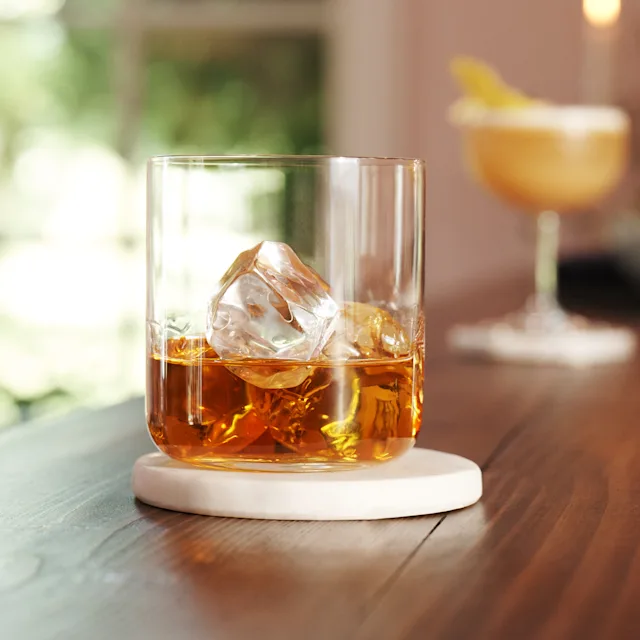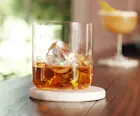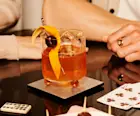The Beginner’s Guide to Different Whisky Types
Whisky, whiskey, Scotch, malt, bourbon. Poured neat or over ice. Sometimes the base for a simple but sophisticated cocktail. Out of all the spirits, surely this is one of the more straightforward? You would think.
Ask any whisky lover about their favourite malt, and you’ll soon find yourself inundated with fascinating, yet perhaps overwhelming, knowledge. But it needn’t feel daunting. For everything you’ve ever wanted to know (but didn’t want to ask), we’re here to help.

What are the different types of whisky?
The simplest way to approach whisky types is to break it down by the country of origin, and the main categories are:
Scotch whisky
American whiskey (including bourbon)
Irish whisky
Japanese whisky
The reason for this approach is because different countries follow different legalities and rules for categorisation, which means trying to offer up one simple catch-all definition can get difficult.
For example, the UK requires something be aged for at least three years in oak to be classed as a whisky, but American whiskies have different rules for different categories.
Scotch whisky 101: what is it and what are the different types?
Scotch whisky is arguably what most people think of when they think of whisky – and it simply means any whisky distilled in Scotland using water and grain.
The Scotch Whisky Association breaks down that anything claiming to be a scotch whisky – sometimes simply called Scotch, depending on the locale – can be made from malted barley, wheat, corn, rye or oats, but every part of the process (including fermentation and distillation) must take place on-site in Scotland.
For a scotch whisky to be correctly classified as such, some other factors must be met. These include:
Only enzymes naturally produced by the grain are allowed to be used
Only yeast is used in the fermentation process
It must be distilled to less than 94.4% ABV and aged in oak barrels of 700 litres or less for at least three years
No additives are allowed other than E150a caramel colour (which is solely for colour and does not affect the taste) and water.
The spirit must be a minimum of 40% ABV when bottled.
"Out of all the spirits, surely this is one of the more straightforward? You would think."
American whiskey 101: bourbon and beyond
Outside of Scotch, one of the biggest markets for producing whisky is the United States. Spelled whiskey – for no reason other than that’s just how it turned out – the two most popular categories are rye whiskies and bourbon.
In the US, all rye whiskies must be made from a mash of at least 51% rye – a cereal grain. Rye is usually mixed with corn or malted barley to produce a rye whiskey. The whiskey must be distilled at no more than 80% ABV and is barrelled at no more than 62.5% ABV. Any rye which has been aged for at least two years and hasn't been blended with other spirits can be considered straight rye whiskies. A rye whiskey is usually spicy or fruity in flavour.
A tentpole of traditional American culture – rooted in the rise of the agricultural American South to a favourite trope in country songs – nothing sums up America’s pioneering spirit in distillation than the sweet bourbon whiskey. To be a bourbon, it must be made from a mash bill of at least 51% corn, distilled to no more than 80% ABV and barreled at no more than 62.5% ABV. There’s no ageing limit, and distillers can use as much corn as long as it’s over 51%.

So, what is a blended Scotch whisky?
Even within this specific category, there are different types of Scotch whisky – and as you explore your burgeoning passion, you’ll hear a lot about blended whiskies and single malts.
The Scottish Whisky Association define the five types of Scotch whisky as:
Single malt - These are whiskies which have been produced at one distillery, using the traditional copper pot distillation (brands include The Singleton)
Single grain - Whiskies produced at one grain distillery, but using a Coffey still, a type of continuous distillation
Blended malt - A whisky made from more than one malt distillery, mixing together different single malts (brands include Johnnie Walker)
Blended grain - A whisky made of more than one grain distillery
Blended Scotch - A whisky made from any number of malt and grain whiskies, mixing products from numerous distilleries.
Irish whiskey and Japanese whisky: unique and pioneering
Like America, Irish whiskey also adds an ‘e’, but spelling aside, it shares more traits with a Scotch whisky. As long as it’s made anywhere on the Emerald Isle – Northern Ireland or the Republic of Ireland - like Scotch, Irish whiskies must be distilled to less than 94.8% ABV, and be aged for at least three years in vessels 700 litres or less. However, some key differences include Irish whiskies permit the addition of exogenous enzymes – these are enzymes not naturally produced by the grain. Further, Irish whiskies have a looser definition on what barrels they can be aged in. To be classified, it simply must take place in ‘woods such as oak’ – which allows for a wider variation. Their signature is the pot still Irish whiskey – a special, unique blend not made anywhere else in the world. It requires the liquid be made from a mash that is at least 30% unpeated malted barley, 30% unmalted barley, and other unmalted cereals. It must then be distilled in pot stills, either two or three times. This way of producing the drink dates back to the 19th century, when they made the drink with a blend of malted and unmalted barley, thought to be a way around British tax laws on malted barleys.

The heir of a sake brewer, Masataka Taketsuru is hailed as the pioneer of Japan’s whisky industry – and it’s all down to a trip to Scotland. A budding chemist, he studied at the University of Glasgow in the summer of 1919. This led to various apprenticeships at distilleries across Scotland, inspiring him to set up his own whisky division upon his return to Japan. He eventually founded his own whisky company – named Nikka today – and the first whisky was sold in October 1940. Tighter rules around Japanese whisky came into force on March 31, 2024. Until around 2021, Japanese whisky never really had a formal definition, which led to distillers blending their whiskies with ingredients from other countries. In 2021, the Japan Spirits & Liqueurs Makers Association (JSLMA) set out some key points which would come into effect by 2024. The rules now state:
It must be fermented, distilled and aged at a distillery in Japan
It must contain malted grain but other non-malted cereal grains can also be included
It must use water extracted only in Japan
It must be aged for at least three years
It must be bottled in Japan.

Here ends our whistle-stop tour through the different types of whisky, where together we covered whisky from around the world. Now you're clued up on the differences, perhaps you're in the mood to select a beginner-friendly whisky? We have a guide just for that.

Explore the world of Malts

From American bourbon to Scotch whisky, read our handy guide to the different types of whisky, how they’re made and how they differ.

From peaty whisky to fruity whisky, lean on our expert insights to discover the full variety and character of different whisky flavours.

Choosing the correct beginner whisky is an important step for any budding malts enthusiast. Let us help you start your journey.

Professional whisky tasting takes practice. Use our do's and don'ts to demystify the experience and enjoy your drams in a whole new way.